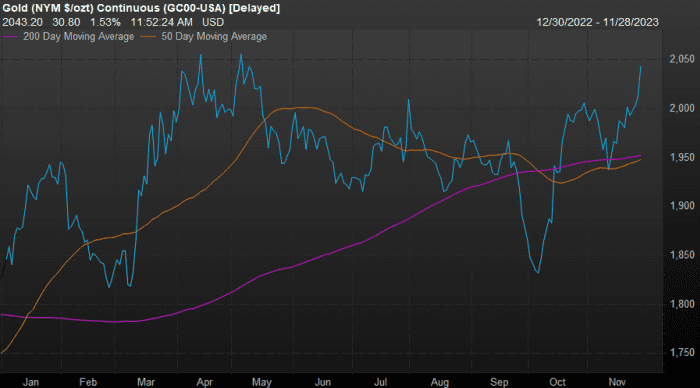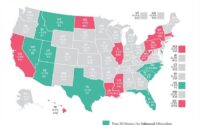Gold rallies toward ‘golden cross’ after defying bearish signal
Gold futures have climbed to their highest prices since August 2020, just eight weeks after a death cross in prices signaled the potential for further weakness.
That marks a shift in the market toward a bullish indicator known as a “golden cross,” which happens when a short-term moving average climbs past a long-term moving average.
Gold futures were on track to soon reach that technical milestone. As of Wednesday, most-active futures
GC00,
saw the 50-day moving average at $1,950.50 and its 200-day moving average at $1,953.29, according to Dow Jones Market Data. The February gold futures contract
GCG24,
settled at $2,067.10 an ounce on Comex, the highest finish since Aug. 6, 2020.

Most-active gold futures are headed for a golden cross, roughly 2 months after a death cross.
FactSet
The gold-backed SPDR Gold Shares exchange-traded fund
GLD,
however, is much closer to reaching its golden cross. In Wednesday trading, the ETF’s 50-day moving average was at $179.91 and its 200-day moving average climbed to $180.20.
“Whether or not gold enters the golden cross, the investment case for gold is strong,” said Joy Yang, head of product management and marketing at index provider MarketVector.
It isn’t so much a question of what’s been boosting gold, but more about what was holding it back, she told MarketWatch.
The precious metal, in particular, had a strong push higher in October — buoyed by the “tragic and shocking geopolitical events in the Middle East,” despite the strength in the U.S. dollar. That “validated” gold’s role as a safe haven and the verity in magnitude of the events, said Yang.
Price support
Gold traded above the key $2,000 mark a number of times this year, but has so far failed to reach fresh record highs as some predicted for this year.
Gold had been striving to break out of its range bound trading all year, but the “force was strong in the dollar and inflation persevered,” said Yang. Both of those increase the opportunity cost of buying and holding gold.
Still, gold’s appeal as a hedge against inflation, economic uncertainty, and expectations that the U.S. Federal Reserve may not raise interest rates in the near term, along with the safe-haven boost from geopolitical uncertainty, have provided support for gold prices this year, said Ryan McIntyre, managing partner at Sprott Inc. and senior portfolio manager at Sprott Asset Management.
Strong central bank net purchases of the precious metal are also among the factors driving gold this year, said Yang, adding that those purchases appear to be on track to beat the record level seen in 2022.
Read: Global central-bank gold purchases reach a record high for the first 9 months of the year
Gold prices are headed higher against a market backdrop where modern capital markets have “not had to deal with a global pandemic and the aftermath of policy response, social shifts and geopolitical shocks on this scale,” said Yang. “So maybe our scale and thresholds are a little off.”
Still, the “underlying investment and macro drivers are there — it’s just they come with wider uncertainty and wider noise,” she said.
Yang pointed out that gold is “rather a unique asset class in that it is driven by a number of differing demand factors: safe haven, investment asset, currency, collectable, industrial use” among others. “Any one of these can dominate or counter the others in heightened times.”
Shift away from a death cross
The climb in gold prices comes less than two months after gold futures on Oct. 5 officially reached a death cross, a technical term for when an investment’s short-term moving average falls below a longer-term moving average.
“All technical indicators hold value, but cannot be considered in insolation,” said Jake Hanley, managing director and senior portfolio manager at Teucrium. “Ultimately, it is price that is king, and all technical indicators are evaluating an asset’s price.”
A death cross is generally viewed as an indication of weakness ahead for the asset but instead, gold prices bottomed out for the period before moving past $2,000 to reach their highest in more than six months, moving closer toward a golden cross.
The move in early October was a “signature shake-out” that you see at the start of a fresh bull market,” said Peter Spina, president of GoldSeek.com, told MarketWatch.
“The market was exhausting itself in perfect harmony with U.S. Treasury yields peaking,” said Spina. “The conditions were ripe to trap some speculators short the market. Technical indicators were in their favor but not fundamentals which have been golden.”
The situation is different because the “fundamentals are supporting the gold price tremendously with near record central bank gold buying,” he said.
Still, Hanley said that while the gold price chart has a bullish setup, with a potential golden cross as one bullish indicator, prices of the precious metal have retreated from similar levels three times since 2020.
Given that, he believes most traders are going to “wait for a confirmed breakout above all-time highs before taking a full position, anticipating a continued bull run for gold.”
Record highs?
For now, U.S. gold investors are likely to focus on the state of financial markets given the increase in Treasury yields and “currently extended valuations for U.S. equities,” said Sprott’s McIntyre. This could lead to a “change in attitude toward risk, which could benefit gold.”
MarketVector’s Yang, meanwhile, said gold’s upside will be strongly tied to the dollar, and dollar downside is strongly tied to the relative strength of the U.S. economy to the rest of the world.
In Wednesday dealings, the ICE U.S. Dollar index
DXY
year to date has lost 0.8%.
Yang believes we are headed to a “quiet end of the year,” but with the U.S. election next year, volatility will increase in 2024.
Year to date, most-active gold futures trade 13% higher.
As gold nears record highs, it’s likely to “face a price battle,” Spina said, noting that he would “not bet against this market as it is prepared to make its big move in the coming months.”
Over the coming weeks, the market may see price consolidation around $2,000, with the potential for a pattern of price pullbacks from “being ‘eaten up’ by hungry buyers — more of whom believe the gold price is about to make a leap higher to $2,500 or even $3,000 on this breakout move, Spina said.
Unless there is a big market selloff or a massive liquidity squeeze, “there is not much stopping the gold price for revaluing itself against depreciating fiat currencies,” he said. The “ingredients are right for [gold] to breakout” by the end of this year, but it could take a big more time into early 2024, said Spina. The “odds favor a move here that will accelerate and take out record highs next month.”
[ad_2]
Source link
Related Posts

Americans ditched high-tax Democrat-run states for low-tax or no-tax havens

US Now Pays More Than Vietnam or Morocco to Borrow
